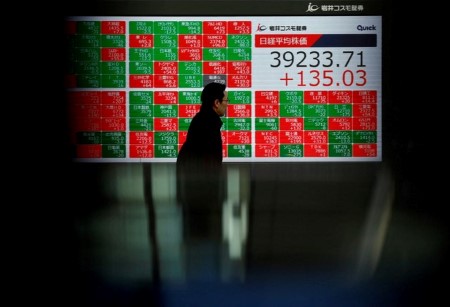




Policy Rate Updates: Double cut finale
 DOWNLOAD
DOWNLOAD

Monthly Economic Update: One for the road
 DOWNLOAD
DOWNLOAD

Inflation Update: Still low, still slow
 DOWNLOAD
DOWNLOAD


US yields bite, China enjoys rare surprise

July 2 – A look at the day ahead in Asian markets.
Asia lagged what was a pretty solid start to the new quarter for global stocks on Monday, and the steep rise in U.S. Treasury yields suggests it will be difficult session again on Tuesday for regional equities and emerging assets more broadly.
The 10-year U.S. yield jumped 13 basis points to 4.50% on Monday – the highest yield and biggest one-day rise in a month – as investors repriced the potential inflationary impact from mooted fiscal, tariff, and immigration policies under a Donald Trump presidency.
Wall Street, European, and world stocks powered through that headwind, Japanese stocks got a lift from the yen’s slide back through 161.00 per dollar, and Chinese stocks drew strength from a positive surprise in domestic manufacturing sector data.
But broad measures of Asian and emerging equities flatlined and they may struggle to rebound meaningfully, if at all, in the face of such a sharp rise in dollar-denominated borrowing costs.
There isn’t anything on the local economic and policy calendar that looks like giving markets a significant steer on Tuesday, with only South Korea inflation and retail sales from Hong Kong scheduled for release.
It’s ‘Groundhog Day’ for yen traders, on intervention watch again with the yen mired at 38-year lows against the dollar. Japanese authorities have not shown their hand yet – could they be waiting for the July 4 U.S. holiday to catch the market off-guard and get maximum impact?
Chinese markets opened the new quarter with a spring in their step after the release on Monday of surprisingly upbeat manufacturing purchasing managers index.
The ‘unofficial’ S&P Global PMI for May pointed to the fastest pace of manufacturing sector growth in more than three years, contrasting with the National Bureau of Statistics’ ‘official’ PMI on Sunday that showed a contraction in factory activity.
But figures on Monday also showed that new home prices in June rose at the slowest rate in five months, suggesting recent government efforts to support the country’s ailing property sector are having only a limited impact so far.
Perhaps rattled by the economy, Beijing is taking new steps to boost the inflow of foreign capital into the country and halt the recent plunge in domestic interest rates.
Tuesday’s main data point in Asia will be South Korean inflation for June. Prices are forecast to have risen 0.1% on a monthly basis and 2.7% on an annual basis, according to a Reuters poll. Both readings would be unchanged from May.
The last time annual headline inflation was this low was last July, while core inflation of 2.2% in May was the lowest since December 2021. More numbers like that and Bank of Korea could soon cut interest rates.
Reporting by Jamie McGeever
This article originally appeared on reuters.com





 By Reuters
By Reuters